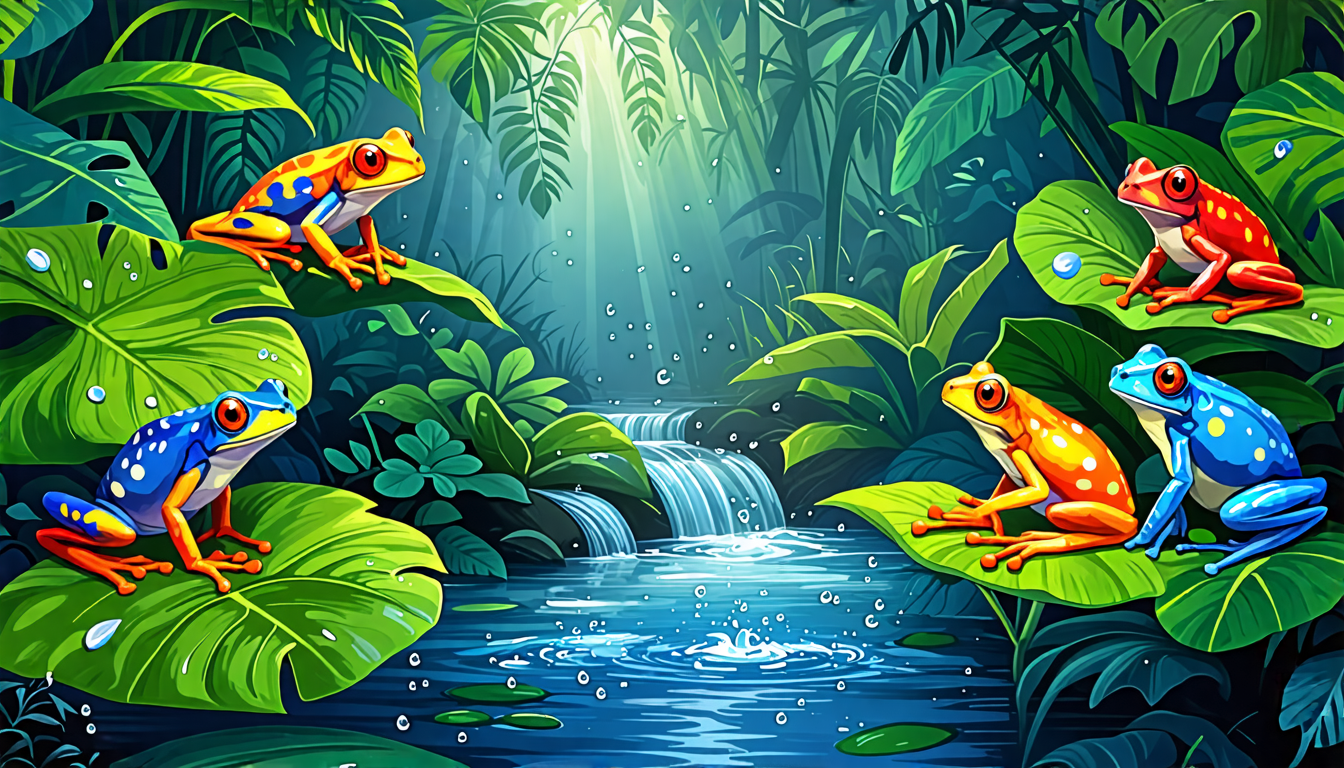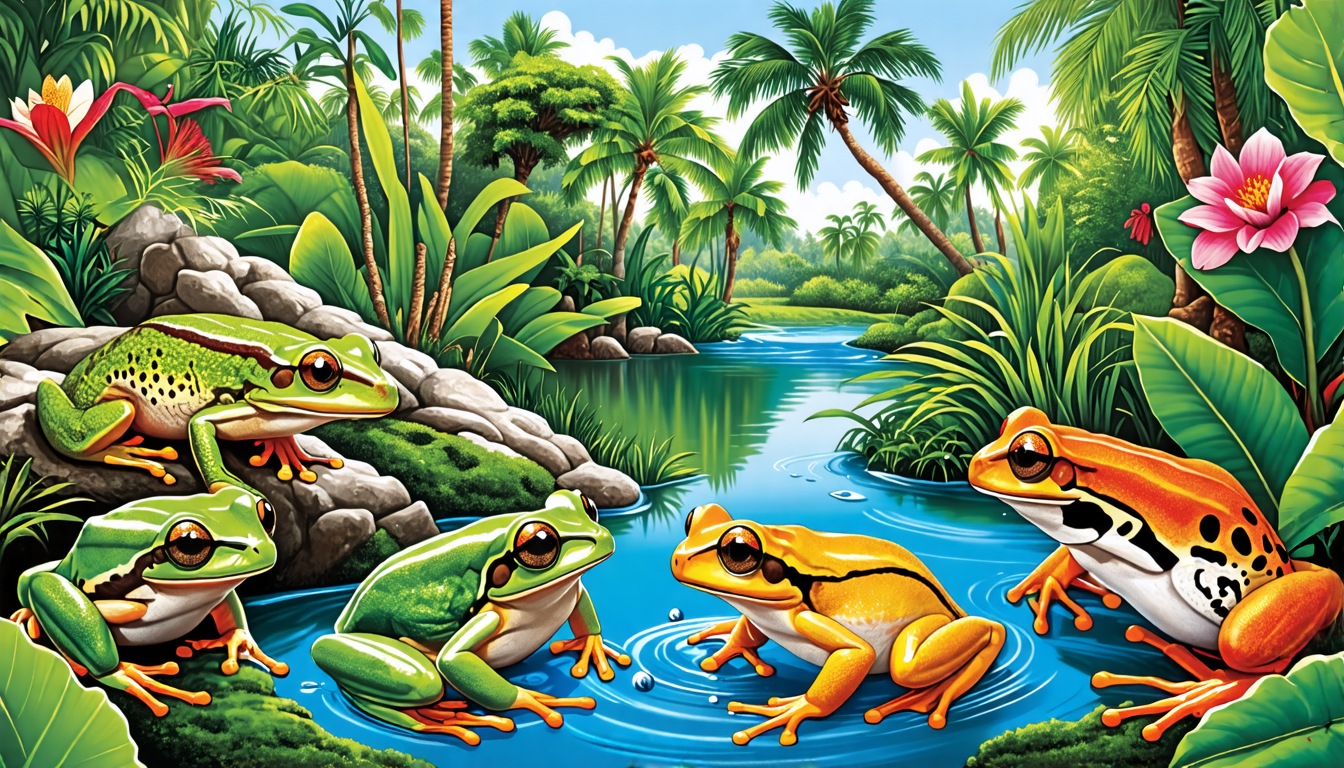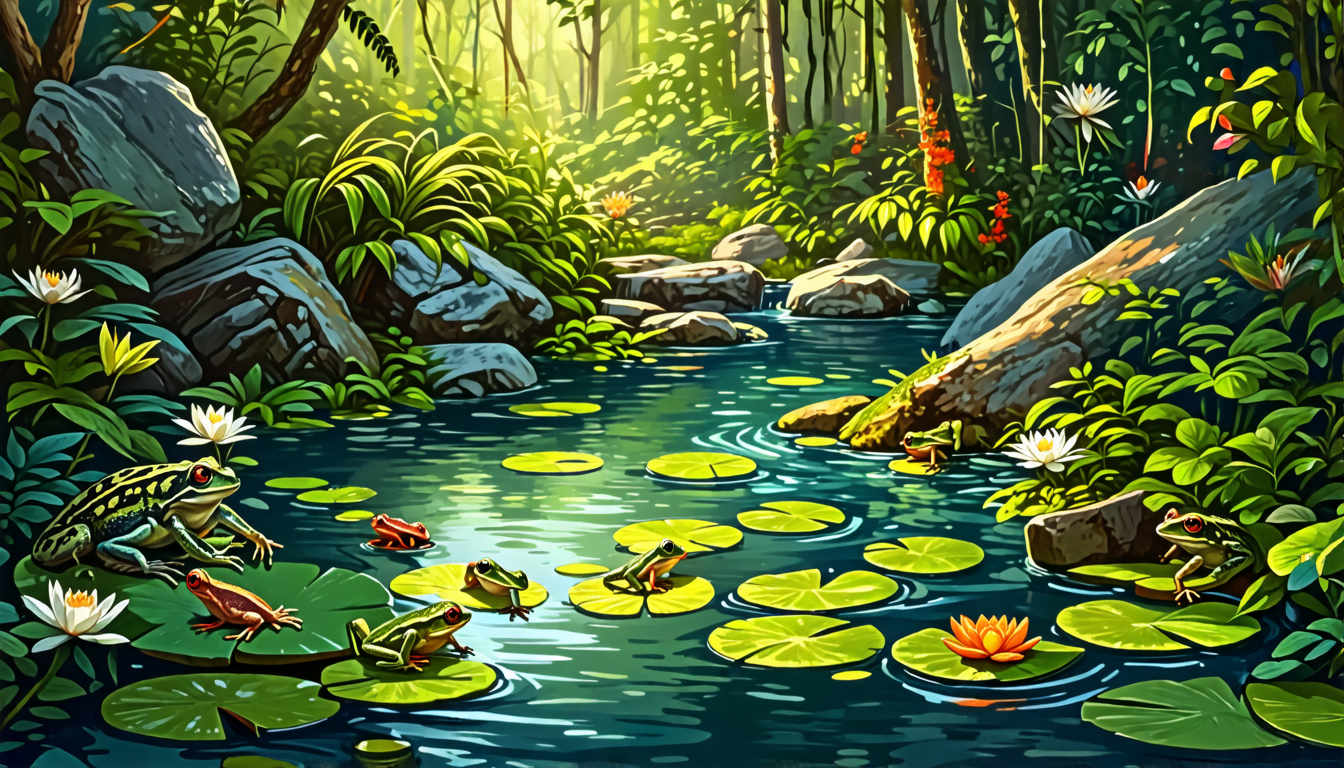
Understanding Tree Frog Water Needs
Tree frogs are remarkable creatures that thrive in diverse habitats ranging from lush forests to arid grasslands. Understanding tree frog water needs is crucial, as these amphibians rely heavily on moisture-rich environments to sustain their health and survival. Water is not just a necessity; it plays a vital role in their biological functions, from skin respiration to reproduction. Different species of tree frogs exhibit unique preferences, with some requiring constant access to standing water, while others are more adaptable to varying moisture levels.
Recognizing these specific water needs is essential for anyone considering tree frogs as pets or those interested in conserving their natural habitats. In this article, we will explore the factors that influence tree frog hydration, best practices for creating suitable water sources in captivity, and the signs of dehydration to monitor. Whether you are a budding herpetologist or a dedicated pet owner, this comprehensive guide will equip you with the knowledge needed to ensure the well-being of these fascinating amphibians. Dive in to discover how you can create the perfect aquatic environment for your tree frog companions!
Overview of Tree Frogs and Their Natural Habitats
Tree frogs are fascinating amphibians known for their vibrant colors and unique adaptations to arboreal life. Unlike many other frogs, tree frogs thrive in various habitats, primarily found in tropical and subtropical regions across the globe. From lush rainforests to temperate woodlands, these remarkable creatures can be spotted high in the branches of trees or nestled in foliage near water sources.
Their natural environments often include ponds, streams, and rain-soaked forests, all of which provide the hydration essential for their survival. These habitats play a critical role in meeting the water needs of tree frogs, as they rely heavily on both the availability and quality of moisture in their surroundings.
Importance of Water for Tree Frog Health and Survival
Water is paramount to the health and well-being of tree frogs. These amphibians possess permeable skin, through which they absorb water. This unique characteristic makes them especially susceptible to dehydration. A consistent and adequate water supply is crucial for maintaining their bodily functions and overall health.
When discussing tree frog water needs, it’s essential to understand that these frogs do not only require water for hydration but also for various life processes. Water acts as a medium for respiration, digestion, and reproduction. In addition, the presence of water is vital for skin moisture, as dry skin can lead to severe health issues and even death.
It’s alarming to note that studies reveal nearly 30% of frog species are facing extinction, primarily due to habitat loss and changes in their water sources. For this reason, focusing on tree frog water needs is an essential step toward conservation efforts and ensuring their survival.
Common Species and Their Specific Water Requirements
Different tree frog species exhibit varying preferences and needs concerning water. Here, we highlight a few common species to understand their specific water requirements better:
1. Red-Eyed Tree Frog (Agalychnis callidryas)
Native to Central America, the red-eyed tree frog thrives in humid rainforests. They prefer shallow pools or ephemeral water bodies for breeding and require a high level of humidity in their ecological niche to prevent dehydration. When kept in captivity, it’s crucial to maintain a consistently moist environment.
2. White’s Tree Frog (Litoria caerulea)
Known for its calm demeanor, the white’s tree frog prefers a slight humidity level of about 50-70%. They benefit from a water source where they can soak periodically, as this helps them maintain healthy skin. Providing a shallow dish of clean water is a great way to meet their hydration needs.
3. Cuban Tree Frog (Osteopilus septentrionalis)
This resilient species can be found in a variety of habitats, including urban areas. While they can tolerate some dryness, regular access to water is still significant for their health, especially during breeding. A small enclosure with a water dish can mimic their natural environment and cater to their water needs effectively.
The Impact of Water Needs on Tree Frog Conservation
Understanding the tree frog water needs is not just an academic exercise; it bears significant conservation implications. With the rapid deterioration of natural habitats due to climate change, urbanization, and pollution, the availability and quality of water sources for tree frogs are compromised.
By providing easy access to clean water sources and structured environments that mimic their natural habitats, we create a sanctuary for tree frogs in captivity. This can also significantly contribute to their survival rates in the wild, especially for endangered species that rely heavily on specific moisture levels and clean water quality.
In conclusion, recognizing and addressing the unique water needs of tree frogs is crucial for both their health and their continued existence. Understanding their ecological requirements and ensuring proper hydration can make all the difference in the lives of these mesmerizing amphibians.
For more detailed information on creating a suitable environment for tree frogs, check out Amphibian Conservation.

Factors Influencing Tree Frog Water Needs
Habitat Preferences and Geographical Variations
Tree frogs are incredibly adaptive creatures, yet their water needs can fluctuate significantly depending on their natural habitats and geographical locations. Understanding these preferences is key to providing optimal care, whether in the wild or captivity.
Most tree frog species thrive in humid environments, often in tropical and subtropical regions. For instance, the Red-Eyed Tree Frog, indigenous to Central American rainforests, requires regular access to standing water and a humid atmosphere. Conversely, species like the Western Tree Frog, found in drier, more temperate climates, show a higher tolerance for lower humidity levels but still need adequate hydration during the breeding season.
Moreover, local climate plays a significant role in determining water needs. In arid regions, tree frogs may rely on specific water sources like rain puddles, while those in rainforest ecosystems depend heavily on constant humidity and moisture. Understanding your specific species and their native environment helps replicate their needs effectively.
Seasonal Changes and Their Impact on Hydration
Seasonal changes can drastically influence the hydration and humidity levels that tree frogs require. As temperatures rise during summer months, evaporation increases, which can lead to dehydration among tree frogs. For instance, studies show that higher temperatures can cause a 30% increase in water loss through skin transpiration.
During the rainy season, many tree frog species experience a boom in breeding activities as they require more water for reproduction. They will often congregate around temporary ponds to lay eggs, making access to clean water indispensable during this season. Conversely, a lack of rainfall not only decreases available water sources but also increases competition among frogs, making adequate hydration critical for survival.
In captivity, it’s crucial to mimic these seasonal fluctuations. Providing a variety of hydration methods such as misters or keeping a consistent water source can help replicate these natural changes and provide a more suitable environment for your tree frogs.
The Role of Water Quality in Tree Frog Health
Water quality is another essential factor influencing tree frog water needs. Contaminated or stagnant water can expose frogs to harmful pathogens and chemicals, adversely affecting their health. A shocking statistic reveals that nearly 90% of amphibian species are affected by habitat changes like water pollution.
When setting up water sources for tree frogs, consider using dechlorinated water, as chlorine can harm these sensitive creatures. Regular water changes, ideally every few days, can help ensure a healthy environment. Additionally, incorporating a filtration system can maintain water quality by removing impurities and preventing stagnation.
In captivity, many enthusiasts utilize a substrate such as peat or live plants in their water dishes, further assisting with water clarity. Not only do these methods keep the water clean, but they also create a more naturalistic environment that can reduce stress levels among the frogs. By prioritizing water quality, you can promote better health, mitigate disease risk, and ultimately, support the vibrant activity levels that tree frogs are known for.
| Water Quality Factor | Impact on Tree Frogs |
|---|---|
| Chlorine | Can harm the skin and respiratory systems |
| Stagnation | Promotes bacterial growth and disease |
| Pollutants | Increases stress and mortality rates |
By recognizing the importance of various environmental factors, such as habitat preferences, seasonal changes, and water quality, frog owners can cater to their unique tree-frog water needs. With informed care practices, we can create better conditions for tree frogs, promoting their longevity and well-being for both wild and captive populations.

Best Practices for Meeting Tree Frog Water Needs
Creating a Suitable Water Source in Captivity
To effectively meet tree frog water needs in a captive environment, it is crucial to establish a water source that mimics their natural habitat. Here are some recommendations:
1. Water Dish: Provide a shallow water dish that is wide enough for your tree frog to enter but not too deep that they could drown. Ideally, the water should be free from chlorine and other chemicals, which can be harmful. Consider using dechlorinated tap water, rainwater, or distilled water for this purpose.
2. Misting Systems: Regular misting can create a humid environment tree frogs thrive in. Misting once or twice daily helps maintain moisture levels and allows tree frogs to soak up water from their skin. Automated misting systems can take the guesswork out of this process and provide consistent humidity.
3. Waterfalls or Drippers: Tree frogs love moving water. Installing a small waterfall or dripper system can create a naturalistic look while supplying a consistent source of hydration. This also prevents stagnation, which can be detrimental to amphibian health.
Maintaining Optimal Humidity Levels
Humidity plays a vital role in meeting tree frog water needs. Here’s how to maintain that perfect balance in their habitat:
- Humidity Gauges: Invest in a hygrometer to monitor humidity levels consistently. Most tree frogs prefer environments with humidity levels between 50% and 70%, depending on the species. Regularly check and adjust the room’s conditions to maintain ideal moisture levels.
- Live Plants: Incorporating live plants into your frog’s enclosure can naturally increase humidity. Plants release moisture through transpiration, creating a more humid atmosphere while also providing shelter.
- Avoid Stagnation: Standing water can lead to bacterial growth that is harmful to tree frogs. Change the water in their dish regularly, at least every few days, to keep it fresh. If using a misting system, ensure the enclosure doesn’t become overly damp, leading to mold growth.
Recognizing Signs of Dehydration
Being proactive about tree frog water needs also means recognizing the signs that your pet may be dehydrated. Here are key indicators to look out for:
1. Skin Texture: Dehydrated tree frogs often display shriveled or dull skin, losing the healthy sheen that indicates adequate hydration.
2. Behavioral Changes: If your tree frog becomes lethargic, spends more time out in the open, or stops climbing, these could be signs of dehydration. Active and healthy frogs are typically exploratory and engage with their environment.
3. Sunken Eyes: One of the most telling signs of dehydration is sunken or hollowed eyes. Healthy tree frogs should have round, bulging eyes without any visible sinking.
Effective Solutions for Dehydration
If you suspect your tree frog is dehydrated, quick action is essential. Here are the steps you can take:
- Soaking: Place your tree frog in a shallow dish of dechlorinated water for about 15 to 20 minutes. This allows them to absorb moisture through their skin. Monitor them closely during this time.
- Adjusted Humidity: Improve the humidity levels in the enclosure immediately. Increase misting frequency, add more live plants, or utilize a humidity-retaining substrate.
- Veterinary Consultation: If dehydration persists despite your efforts, consult a veterinarian who specializes in amphibians. They can provide guidance or treatment to improve your tree frog’s health.
Conclusion
Gathering the right resources and knowledge will empower you to meet your tree frog water needs effectively. Providing a suitable water source, maintaining proper humidity, and quickly addressing signs of dehydration are essential components of effective tree frog care. By taking a proactive approach, you can ensure your little friend thrives in a healthy and hydrated environment.
For further information on amphibian care and specific needs, consider checking out the resources available at Amphibian Foundation.
In conclusion, understanding the water needs of tree frogs is essential for both their health and longevity, whether in their natural habitat or captivity. By recognizing the various factors that influence their hydration, such as habitat preferences, seasonal changes, and water quality, you can create an environment that closely mimics their natural surroundings.
Implementing best practices for providing adequate water sources, maintaining optimal humidity, and staying vigilant for signs of dehydration will help ensure your tree frogs thrive. Remember, proper water management not only enhances the quality of life for these fascinating amphibians but also contributes to their ongoing vitality.
By prioritizing their water needs, you’ll create a sustainable and nurturing environment that honors the unique qualities of tree frogs. As stewards of these remarkable creatures, let’s commit to their care and ensure they flourish for years to come. For those seeking further insights into amphibian care, consider exploring resources from reputable organizations such as the Amphibian Conservation Network.
